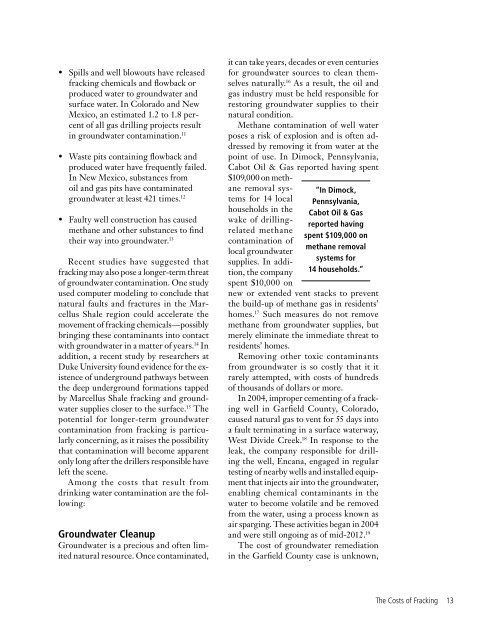The Costs of Fracking
The Costs of Fracking vMN.pdf - Environment Minnesota
The Costs of Fracking vMN.pdf - Environment Minnesota
Create successful ePaper yourself
Turn your PDF publications into a flip-book with our unique Google optimized e-Paper software.
• Spills and well blowouts have released<br />
fracking chemicals and flowback or<br />
produced water to groundwater and<br />
surface water. In Colorado and New<br />
Mexico, an estimated 1.2 to 1.8 percent<br />
<strong>of</strong> all gas drilling projects result<br />
in groundwater contamination. 11<br />
• Waste pits containing flowback and<br />
produced water have frequently failed.<br />
In New Mexico, substances from<br />
oil and gas pits have contaminated<br />
groundwater at least 421 times. 12<br />
• Faulty well construction has caused<br />
methane and other substances to find<br />
their way into groundwater. 13<br />
Recent studies have suggested that<br />
fracking may also pose a longer-term threat<br />
<strong>of</strong> groundwater contamination. One study<br />
used computer modeling to conclude that<br />
natural faults and fractures in the Marcellus<br />
Shale region could accelerate the<br />
movement <strong>of</strong> fracking chemicals—possibly<br />
bringing these contaminants into contact<br />
with groundwater in a matter <strong>of</strong> years. 14 In<br />
addition, a recent study by researchers at<br />
Duke University found evidence for the existence<br />
<strong>of</strong> underground pathways between<br />
the deep underground formations tapped<br />
by Marcellus Shale fracking and groundwater<br />
supplies closer to the surface. 15 <strong>The</strong><br />
potential for longer-term groundwater<br />
contamination from fracking is particularly<br />
concerning, as it raises the possibility<br />
that contamination will become apparent<br />
only long after the drillers responsible have<br />
left the scene.<br />
Among the costs that result from<br />
drinking water contamination are the following:<br />
Groundwater Cleanup<br />
Groundwater is a precious and <strong>of</strong>ten limited<br />
natural resource. Once contaminated,<br />
it can take years, decades or even centuries<br />
for groundwater sources to clean themselves<br />
naturally. 16 As a result, the oil and<br />
gas industry must be held responsible for<br />
restoring groundwater supplies to their<br />
natural condition.<br />
Methane contamination <strong>of</strong> well water<br />
poses a risk <strong>of</strong> explosion and is <strong>of</strong>ten addressed<br />
by removing it from water at the<br />
point <strong>of</strong> use. In Dimock, Pennsylvania,<br />
Cabot Oil & Gas reported having spent<br />
$109,000 on methane<br />
removal systems<br />
for 14 local<br />
households in the<br />
wake <strong>of</strong> drillingrelated<br />
methane<br />
contamination <strong>of</strong><br />
local groundwater<br />
supplies. In addition,<br />
the company<br />
spent $10,000 on<br />
“In Dimock,<br />
Pennsylvania,<br />
Cabot Oil & Gas<br />
reported having<br />
spent $109,000 on<br />
methane removal<br />
systems for<br />
14 households.”<br />
new or extended vent stacks to prevent<br />
the build-up <strong>of</strong> methane gas in residents’<br />
homes. 17 Such measures do not remove<br />
methane from groundwater supplies, but<br />
merely eliminate the immediate threat to<br />
residents’ homes.<br />
Removing other toxic contaminants<br />
from groundwater is so costly that it it<br />
rarely attempted, with costs <strong>of</strong> hundreds<br />
<strong>of</strong> thousands <strong>of</strong> dollars or more.<br />
In 2004, improper cementing <strong>of</strong> a fracking<br />
well in Garfield County, Colorado,<br />
caused natural gas to vent for 55 days into<br />
a fault terminating in a surface waterway,<br />
West Divide Creek. 18 In response to the<br />
leak, the company responsible for drilling<br />
the well, Encana, engaged in regular<br />
testing <strong>of</strong> nearby wells and installed equipment<br />
that injects air into the groundwater,<br />
enabling chemical contaminants in the<br />
water to become volatile and be removed<br />
from the water, using a process known as<br />
air sparging. <strong>The</strong>se activities began in 2004<br />
and were still ongoing as <strong>of</strong> mid-2012. 19<br />
<strong>The</strong> cost <strong>of</strong> groundwater remediation<br />
in the Garfield County case is unknown,<br />
<strong>The</strong> <strong>Costs</strong> <strong>of</strong> <strong>Fracking</strong> 13



